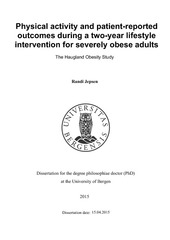| dc.description.abstract | Severe obesity is a chronic condition, which is associated with impaired quality of life and health hazards. The direct cause of obesity is an imbalance in energy intake and expenditure over time, but the underlying mechanisms include a complexity of individual, inter-relational, social, environmental, and political factors. The prevalence of severe obesity is growing in the adult Norwegian population, and the condition gives access to the specialist health services. One treatment option is multi-component lifestyle interventions, which include physical activity, change of diet, and cognitive behavioural therapy. Although physical activity is a cornerstone of such interventions, it is sparsely studied. How physical activity may be associated with subjective phenomena like psychological, predisposing factors or quality of life before and during lifestyle interventions is not known. Therefore, the purposes of the study were 1) to examine associations between physical activity and quality of life outcomes prior to a lifestyle intervention, 2) to examine associations between change in the three psychological, predisposing factors perceived behavioural control over physical activity, self-efficacy for physical activity in the face of psychological barriers, and physical activity identity and change in physical activity during a two-year lifestyle intervention, and 3) to examine associations between change in physical activity and change in quality of life outcomes during a two-year lifestyle intervention. The study was part of the Haugland Obesity Study, which was a two-year prospective, observational study on severely obese adults participating in a multi-component lifestyle intervention. Residential periods constituted 15 weeks in total at the Red Cross Haugland Rehabilitation Centre, Western Norway. Inclusion criteria were age between 18-60 years and body mass index (BMI) ≥ 40 kg/m2 with or without comorbidities, or ≥ 35 kg/m2 with comorbidities. Exclusion criteria were: referral to, or, previous obesity surgery, severe cardiovascular disease, pregnancy, alcohol or substance abuse, and mental illness or physical impairment that would compromise adherence to the intervention. Ethical approval was obtained from the Regional Committee for Medical and Health Research Ethics for South-East Norway (registration number 2010/159a). Multi-component lifestyle interventions were understood as health promoting activities. The socio-ecological PRECEDE-PROCEED model and its theoretical underpinnings inspired the understanding of the processes of change, the associations, and outcomes.p>Physical activity was assessed using the ActiGraph GTIM accelerometer (ActiGraph, Fort Walton Beach, FL, USA). The unit counts per minute was used for level of physical activity. Psychological, predisposing factors were measured using questionnaires on perceived behavioural control over physical activity, self-efficacy for physical activity in the face of psychological barriers, and physical activity identity. Quality of life was measured using a one-item question on life satisfaction, the Medical Outcomes Study Short-Form 36 Health Survey (SF-36), and the Obesity- Related Problems Scale (OP). Anthropometric data were collected by health staff. Socio-demographic information was obtained from questionnaires. Data collection took place four times: before, during, and at the end of the intervention between February 2010 and October 2012. A linear mixed model based on restricted maximum likelihood estimation with random intercept for subjects was used in analyses for change over time, using least significant difference from baseline. Linear regression analyses were performed to examine associations between variables. Gender, age, and (change in) BMI were used as control variables in the regression analyses. Forty-nine individuals (37 women; 43.6 ± 9.4 years; BMI 42.1 ± 6.0 kg/m2) consented to participate in the study. At year two, 44.9% were lost to follow-up. Attrition analyses did not reveal differences between completers and non-completers. Regression analyses revealed that 1) level of physical activity was positively and independently associated with life satisfaction and physical functioning (obtained from SF-36) but not mental health (obtained from SF-36) prior to the intervention, 2) change in perceived behavioural control was positively and independently associated with change in physical activity during the two years, but self-efficacy and physical activity were not, and 3) change in physical activity was positively and independently associated with change in life satisfaction, the physical and mental component summary scores of SF-36, and obesity-specific quality of life. The conclusions were that perceived behavioural control may be a valid target for increase of physical activity in multi-component lifestyle interventions, and that improvements in quality of life may have the potential to operate as a long-term motivational factor for physical activity in lifestyle interventions for severely obese adults. The findings should be further examined in larger samples and different settings, and should preferably include establishment of a control group. The impact of extra-personal factors on change of physical activity behaviour should also be examined in recognition of the complexity of factors influencing individual healthrelated behaviour. | en_US |
